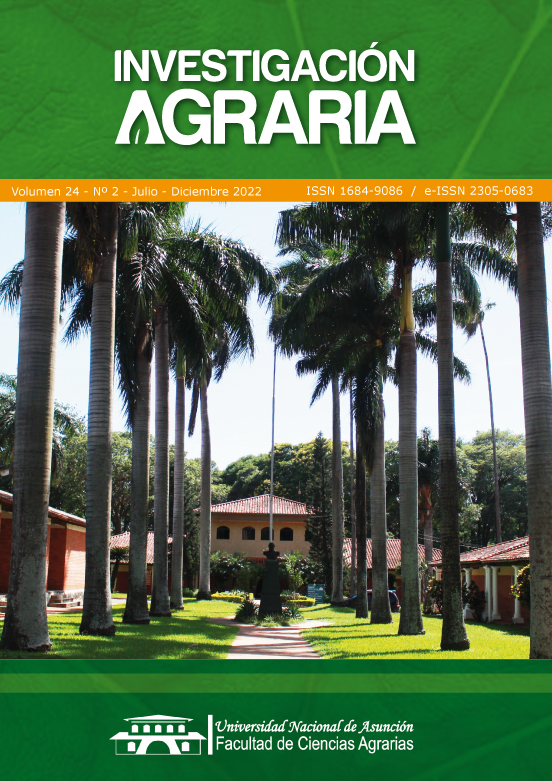Use of vegetable oils in citrus black fly control
DOI:
https://doi.org/10.18004/investig.agrar.2022.diciembre.2402663Keywords:
Aleurocanthuswoglumi Ashby, Blackfly, alternative control, nymphs, synthetic chemicalsAbstract
The use of vegetable oils as an insecticide is one of the ecological alternatives to synthetic chemical insecticides. In order to evaluate the effectiveness of vegetable oils in the control of the citrus black fly, this research was carried out in the Biology Laboratory and in the experimental field of the Faculty of Agricultural Sciences of the National University of Asunción. Two trials were carried out; one in the field and the other in the laboratory, in both cases a completely randomized design with eight treatments and three repetitions was used, the results were subjected to an analysis of variance, followed by a comparison test of means by Tuckey at 5% probability The treatments were: control (without application), suspensions at 2% of mineral oil, new sunflower oil, detergent, recycled sunflower oil, canola oil, corn oil, soybean oil and cottonseed oil, were carried out in total. 2 applications for the field test and 1 application for the laboratory test. Mortality was evaluated in a period of 7 days for the laboratory test and 14 days for the field test, of Aleurocanthuswoglumi Ashby nymphs after the application of the treatments. The effectiveness in the control of the citrus black fly was observed for each of the vegetable oils evaluated in both trials, reaching a mortality of up to 100% in the two applications. All the oils used resulted in mortality rates higher than 90%, after the second application, being evident that the control of the citrus black fly can be carried out through the use of vegetable oils; alternative product to synthetic chemicals.Downloads
Metrics
References
Santos Andrade, G., Luiz Pastori, P., Azevedo Pereira, A. I. De, Pin Dalvi, L., Almeida, G. Dias de, & Fagundes Pereira, F. (2009). Nota sobre el control integrado de AleurocanthuswoglumiAshby (Hemíptera: Aleyrodidae) em Brasil. Boletin Sanidad Vegetal. Plagas, 35, 2259-263.
Boscán, N. (1982). Biología de la mosca prieta de los cítricos Aleurocanthuswoglumi Ashby (Homoptera: Aleyrodidae) en el campo. Caracas. Recuperado de: http://www.sian.inia.gob.ve/revistas_ci/Agronomia%20Tropical/at3116/arti/boscan_n3.htm
Carvalho, J. D. de., Neves, F. L., Silva, C. da., Durval, C. da. & Bitterncourt, M. A. L. (2017). Biological aspects and insecticide action of plant species on eggs and nymphs of citrus black fly (AleurocanthuswoglumiAshby - Aleyrodidae) at laboratory level. Recuperado de:https://dx.doi.org/10.1590/0100-29452017045
Castresan, J. E., Rosenbaum, J. & González, L. A. (2013). Estudio de la efectividad de tres aceites esenciales para el control de áfidos en pimiento, Capsicumannuum L. Disponible en:https://www.researchgate.net/publication/260770738_Estudio_de_la_efectividad_de_tres_aceites_esenciales_para_el_control_de_afidos_en_pimiento_Capsicum_annuum_L
Cuevas-Salgado, M. I., Castañeda-Templos, F. A. & Romero-Nápoles, C. (2015). Aceites comestibles como alternativa de control para lacochinilladelnopal. BoletínSociedad Mexicana de Entomología, 1, 64-70.
De Ong, E. R., Knight, H. & Chamberlin, J. C. (1927). A preliminary study. Of petroleum oil as an insecticide for citrus trees. Hilgardia,2 (9), 251-384.
Di Rienzo, J.,Casanoves, F., González, L., Tablada, E., Díaz, M., Robledo, C. & Balzarini, M. (2009). Estadística para las ciencias agropecuarias. Córdoba, AR, Brujas, 372 p.
Dietz, H. R. & Zetek, J. (1920). The blackfly of citrus and other subtropical plants. Boletín USDA, 885, 1-55. Recuperado de https://archive.org/details/blackflyofcitrus885diet/page/n3
FCA (2019). Datos Metereológicos. San Lorenzo: División de Meteorología, UNA, 5p.
European and Mediterranean Plant Protection Organization. (2002). EPPO Standards: Diagnostic protocols for regulated pests. Disponible en: https://gd.eppo.int/standards/pm7/
González, L. R. & Tullo, C.C. (2019). Guía técnica cultivo de cítricos. San Lorenzo, PY. 80 p.
Gyeltshen, J., Hodges, A. & Hodges, G. (2005). Orange Spiny Whitefly, Aleurocanthusspiniferus (Quaintance) (Insecta: Hemiptera: Aleyrodidae). Disponible en: https://edis.ifas.ufl.edu/in618
Hernández, S., Cabaleiro, C., Jacas, J. & Martín, B. (2002). El empleo de aceites minerales, vegetales y de pescado en el Control Integrado de plagas y enfermedades del viñedo. Boletín Sanidad Vegetal. Plagas, 28, 223-237. Disponible en:https://www.mapa.gob.es/ministerio/pags/Biblioteca/Revistas/pdf_plagas%2FBSVP-28-02-223-237.pdf
Hidalgo, N. P. M., Durante, P. M. & Umaran, A. (2015). Orden Hemíptera. Revista IDE@-SEA, 54, 1-18.
López, B. M. (2006). Uso de aceites en cultivos hortícolas para el control de virosis y de sus vectores. Zaragoza. Disponible en: https://www.agroecologia.net/recursos/publicaciones/publicaciones-online/2006/CD%20Congreso%20Zaragoza/Ponencias/106%20Mart%C3%ADn%20L%C3%B3pez%20Com-%20Uso%20de%20aceites.pdf
López, S. N., Peralta, C., Aguirre, A. & Cáceres, S. (2011). Primer registro de “la mosca negra de los cítricos” Aleurocanthuswoglumi(Hemiptera: Aleyrodidae) en la Argentina. Revista de la Sociedad Entomológica Argentina, 70(3-4), 373-374.
Medeiros, F. R., Lemos, R. N. S. de.,Ottati, L. A. T., Araújo, J. R. G., KlayAx, G. K. & Rodrigues, A. A. C. (2009). Dinâmica populacional da mosca-negra-dos-citros Aleurocanthuswoglumiashby (hemiptera: aleyrodidae) em Citrus spp. no município de São Luís - MA. Revista Brasileira de Fruticultura, 31(4), 1016-1021.
Nguyen, R., Brazzel, J. R. & Poucher, C. (1983). Population density of the citrus blackfly, Aleurocanthuswoglumi Ashby (Homoptera: Aleyrodidae), and its parasites in urban Florida in 1979–1981. Environmental Entomology, 12, 878-884.
Peláez-Arroyo, A., Vargas-Hernández, M., Ayvar-Serna, S., Díaz Nájera, J. F., Acosta-Ramos, M. & Tejeda-Reyes, M. A. (2017). Evaluación de la efectividad biológica de dos extractos vegetales para el control de Aphisgossypii (glover) (hemíptera: aphididae) en un sistema abierto de jitomate. Disponible en: http://www.entomologia.socmexent.org/revista/entomologia/2017/EA/EM0802017_259-264.pdf
Salomão, L. C. C. & Siqueira, D. L de.(2017). Citros do Plantio à Colheita. Brasil. UFV. 278 p.
Silva, J. G. da., Batista, J. L., Silva, J. G. da. & Brito, C. H. de. (2012). Use of vegetable oils in the control of the citrus black fly, Aleurocanthuswoglumi (Hemiptera: Aleyrodidae). Disponible en: http://www.scielo.org.co/scielo.php?script=sci_arttext&pid=S0120-04882012000200003&lng=en&tlng=en.
Tovar, H. (2012). Alternativas biorracionales para el manejo integrado de plagasagrícolas. Disponible en: http://www.culturaorganica.com/html/viewer.php?ID=28&IDPAG=30
Varela, S., Silva, G., Garza, J. & Macias, L.(2007). Manejo de la Mosca Prieta de los cítricos (Aleurocanthuswolglumi Ashby) a través de la estimación de porcentaje de infestación y parasitismo. XI Simposium Internacional de Citricultura. Tamaulipas, MX. Disponible en: http://www.concitver.com/XI%20simposium/MEMORIAS/13%20Curso%20Taller/ManejodelaMosca.pdf
Vázquez-Luna, A., Pérez-Flores, L. & Díaz-Sobac R. (2007). Biomoléculas con actividad insecticida: una alternativa para mejorar la seguridad alimentaria. Disponible en:https://www.tandfonline.com/doi/abs/10.1080/11358120709487705
Published
How to Cite
Issue
Section
License
Copyright (c) 2023 Sayra Magalí Samudio González, Luis Roberto Gonzalez Segnana, Claudia Carolina Cabral Antúnez

This work is licensed under a Creative Commons Attribution 4.0 International License.
All content in this journal is under Creative Commons Attribution License.









 All content in this journal is under
All content in this journal is under 